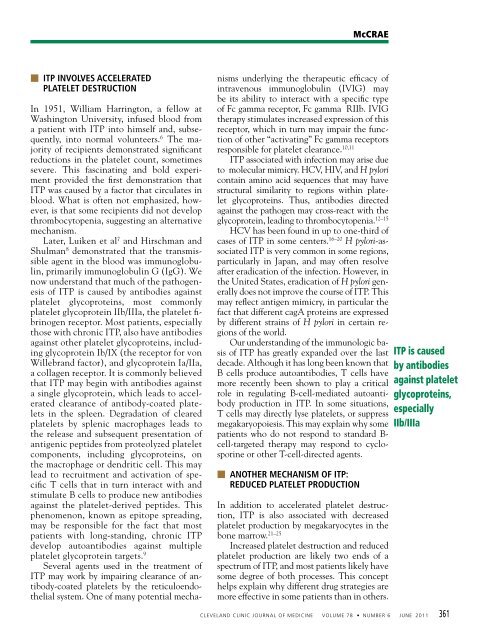Immune thrombocytopenia: No longer 'idiopathic'
Immune thrombocytopenia: No longer 'idiopathic'
Immune thrombocytopenia: No longer 'idiopathic'
You also want an ePaper? Increase the reach of your titles
YUMPU automatically turns print PDFs into web optimized ePapers that Google loves.
■ ITP INVOLVES ACCELERATED<br />
PLATELET DESTRUCTION<br />
In 1951, William Harrington, a fellow at<br />
Washington University, infused blood from<br />
a patient with ITP into himself and, subsequently,<br />
into normal volunteers. 6 The majority<br />
of recipients demonstrated significant<br />
reductions in the platelet count, sometimes<br />
severe. This fascinating and bold experiment<br />
provided the first demonstration that<br />
ITP was caused by a factor that circulates in<br />
blood. What is often not emphasized, however,<br />
is that some recipients did not develop<br />
<strong>thrombocytopenia</strong>, suggesting an alternative<br />
mechanism.<br />
Later, Luiken et al 7 and Hirschman and<br />
Shulman 8 demonstrated that the transmissible<br />
agent in the blood was immunoglobulin,<br />
primarily immunoglobulin G (IgG). We<br />
now understand that much of the pathogenesis<br />
of ITP is caused by antibodies against<br />
platelet glycoproteins, most commonly<br />
platelet glycoprotein IIb/IIIa, the platelet fibrinogen<br />
receptor. Most patients, especially<br />
those with chronic ITP, also have antibodies<br />
against other platelet glycoproteins, including<br />
glycoprotein Ib/IX (the receptor for von<br />
Willebrand factor), and glycoprotein Ia/IIa,<br />
a collagen receptor. It is commonly believed<br />
that ITP may begin with antibodies against<br />
a single glycoprotein, which leads to accelerated<br />
clearance of antibody-coated platelets<br />
in the spleen. Degradation of cleared<br />
platelets by splenic macrophages leads to<br />
the release and subsequent presentation of<br />
antigenic peptides from proteolyzed platelet<br />
components, including glycoproteins, on<br />
the macrophage or dendritic cell. This may<br />
lead to recruitment and activation of specific<br />
T cells that in turn interact with and<br />
stimulate B cells to produce new antibodies<br />
against the platelet-derived peptides. This<br />
phenomenon, known as epitope spreading,<br />
may be responsible for the fact that most<br />
patients with long-standing, chronic ITP<br />
develop autoantibodies against multiple<br />
platelet glycoprotein targets. 9<br />
Several agents used in the treatment of<br />
ITP may work by impairing clearance of antibody-coated<br />
platelets by the reticuloendothelial<br />
system. One of many potential mecha-<br />
McCRAE<br />
nisms underlying the therapeutic efficacy of<br />
intravenous immunoglobulin (IVIG) may<br />
be its ability to interact with a specific type<br />
of Fc gamma receptor, Fc gamma RIIb. IVIG<br />
therapy stimulates increased expression of this<br />
receptor, which in turn may impair the function<br />
of other “activating” Fc gamma receptors<br />
responsible for platelet clearance. 10,11<br />
ITP associated with infection may arise due<br />
to molecular mimicry. HCV, HIV, and H pylori<br />
contain amino acid sequences that may have<br />
structural similarity to regions within platelet<br />
glycoproteins. Thus, antibodies directed<br />
against the pathogen may cross-react with the<br />
glycoprotein, leading to <strong>thrombocytopenia</strong>. 12–15<br />
HCV has been found in up to one-third of<br />
cases of ITP in some centers. 16–20 H pylori-associated<br />
ITP is very common in some regions,<br />
particularly in Japan, and may often resolve<br />
after eradication of the infection. However, in<br />
the United States, eradication of H pylori generally<br />
does not improve the course of ITP. This<br />
may reflect antigen mimicry, in particular the<br />
fact that different cagA proteins are expressed<br />
by different strains of H pylori in certain regions<br />
of the world.<br />
Our understanding of the immunologic basis<br />
of ITP has greatly expanded over the last<br />
decade. Although it has long been known that<br />
B cells produce autoantibodies, T cells have<br />
more recently been shown to play a critical<br />
role in regulating B-cell-mediated autoantibody<br />
production in ITP. In some situations,<br />
T cells may directly lyse platelets, or suppress<br />
megakaryopoiesis. This may explain why some<br />
patients who do not respond to standard B-<br />
cell-targeted therapy may respond to cyclosporine<br />
or other T-cell-directed agents.<br />
■ ANOTHER MECHANISM OF ITP:<br />
REDUCED PLATELET PRODUCTION<br />
In addition to accelerated platelet destruction,<br />
ITP is also associated with decreased<br />
platelet production by megakaryocytes in the<br />
bone marrow. 21–25<br />
Increased platelet destruction and reduced<br />
platelet production are likely two ends of a<br />
spectrum of ITP, and most patients likely have<br />
some degree of both processes. This concept<br />
helps explain why different drug strategies are<br />
more effective in some patients than in others.<br />
ITP is caused<br />
by antibodies<br />
against platelet<br />
glycoproteins,<br />
especially<br />
IIb/IIIa<br />
CLEVELAND CLINIC JOURNAL OF MEDICINE VOLUME 78 • NUMBER 6 JUNE 2011 361
















